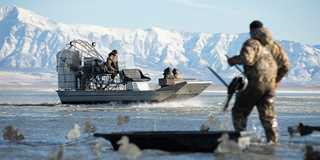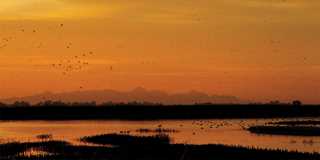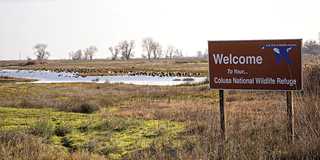Best of the Flyways: Pacific Flyway
Like prospectors clamoring for riches during the gold rush, you can find these treasures and more when you head west
Like prospectors clamoring for riches during the gold rush, you can find these treasures and more when you head west

By Gary Kramer
The Pacific Flyway is the longest and most diverse flyway, stretching from the North Slope of Alaska all the way into Mexico and beyond. Hunters looking for true adventure and mount-worthy birds have plenty of choices. Maybe a harlequin amid Alaskas spectacular scenery. Or a bull pintail in full winter plumage among the Central Valleys rice fields and managed wetlands. Or a cinnamon teal, as unique, beautiful, and precious as the habitats on which it relies. Like prospectors clamoring for riches during the gold rush, you can find these treasures and more when you head west.

Photo Lee T. Kjos/therawspirit.com
Cold Bay is one of those faraway places that many waterfowl hunters have heard about but few have visited. Located on the Alaska Peninsula, 630 miles southwest of Anchorage, Cold Bay is the headquarters for 417,500-acre Izembek National Wildlife Refuge, a vast wilderness of saltwater lagoons, freshwater lakes, and tundra. During the fall migration, up to 200,000 geese and 150,000 ducks use the area. Virtually the entire Pacific black brant population stages at Izembek before their early November departure for points south. A flight from Anchorage to Cold Bay is required, and hiring a guide with a boat, decoys, and local savvy is the best bet.
When to Go
The season opens on September 1 and closes in mid-December. In September and October, puddle ducks and geese are in abundance, Pacific brant are available throughout the season, and sea duck hunting, including action for Pacific eiders, commences in early November. In 2017, for the first time in 30 years, the hunting of emperor geese was authorized.

Photo davidstimac.com
Food and Lodging
For years Izembek Lagoon was the private hunting ground of the locals and a few Alaska residents who made the flight from Anchorage. Guides were scarce, but over time several outfitters moved into the area and set up shop. Check out Bayview Charters or Four Flyway Outfitters. Raven Air makes the once-daily flight to Cold Bay.
Local Attractions
Cold Bay is home to about 125 permanent residents. The state and federal governments, along with the airport and airlines, provide the bulk of the employment. The town even has its own DU banquet, hosted by local volunteers. Home to a two-hole golf course and a single motel and store, Cold Bays main attraction is Izembek National Wildlife Refuge, a mecca for waterfowl and shorebirds and home to caribou, foxes, and brown bears.

Photo Chuck and Grace Bartlett
Historically, waterfowl were attracted to the Columbia Basin of eastern Washington and Oregon because of the regions riversthe Columbia, Yakima, and Snakeand their associated wetlands. However, wintering populations were limited by the amount of available food. That changed in the late 1950s, when center-pivot irrigation came to the basin. Waterfowl began to winter here in increasing numbers. By the late 1970s, waterfowl populations were no longer measured in the thousands but in the millions. The combination of abundant food and secure resting areas on the Columbia River, national wildlife refuges, and state wildlife areas brought waterfowl to the basin in spectacular numbers. Although a good percentage of the farming areas are tied up with hunting leases, there is ample public hunting on several federal and state areas.
When to Go
This is mallard country, and hunting is good throughout the season, particularly late, when temperatures drop and birds become more dependent on waste grain. The Columbia River doesnt ice over, and birds raft up on open water before flying to grain fields to feed.
Food and Lodging

Photo Hale's Restaurant
For accommodations try the Quality Inn in Umatilla, Oregon, and the Oxford Suites in Hermiston. For grub, hunters gather at Hales Restaurant in Hermiston for rare steaks washed down with a Full Sail Ale.
Local Attractions
The Mid-Columbia River National Wildlife Refuge Complex is the headquarters for seven national wildlife refuges in Washington and Oregon. They offer extensive hunting and wildlife-viewing opportunities.

Photo Moose Media
The Great Salt Lake is 75 miles long and covers 1,700 square miles of wetlands and watery wilderness between the urban sprawl of Salt Lake City and the western desert. On average four times saltier than the Pacific Ocean, the lake supports tremendous numbers of brine shrimp. These aquatic invertebrates, along with seed-producing shoreline vegetation, support massive concentrations of waterfowl. State wildlife areas, federal refuges, and numerous outfitters offer hunting on this massive body of water. Many of the prime areas can be reached by airboat, and layout hunting is common. Other than on opening weekend and the Thanksgiving and Christmas holidays, the lake is relatively uncrowded.
When to Go
From opening day in October until the first hard freeze, duck numbers are high. Later in the season the hunting can be excellent, but more scouting is required. The bag is dominated by green-winged teal and shovelers with a smattering of mallards, wigeon, pintails, and divers. Tundra swans can be hunted with a permit. The best action is in October and November as the swans move through the region on the way to their California wintering grounds.

Photo Chuck and Grace Bartlett
Food and Lodging
The Crystal Inn and Howard Johnson are pet-friendly motels in Brigham City. Good food is easy to find at the Idle Isle Cafe, where home-style meals have been served since 1921, and at the Maddox Ranch House, famous for its thick and juicy bison steaks.
Local Attractions
When in Salt Lake City, a visit to Temple Square and a performance of the Tabernacle Choir are worth considering. In late October, the Antelope Island State Park Bison Roundup is on tap. Antelope Island is also home to pronghorn, mule deer, and a variety of bird life.

Photo Michael Peters
California provides the most important waterfowl wintering grounds in the Pacific Flyway. The states vast Central Valley supports peak numbers of between 5 million and 6 million ducks and more than 2 million geese. In total, California is visited by about 60 percent of the Pacific Flyways waterfowl and up to 20 percent of the continental population of ducks and geese.
However, in a state with a population of 39 million people, human pressures have impacted the waterfowl habitat, and wetland acreage has plummeted from nearly 4 million acres in the late 1800s to about 400,000 acres today. Most of the wetlands are in the San Joaquin and Sacramento Valleys, where farming is the predominant land use and wetland habitats hang on like drifting ships in a sea of agriculture. These isolated patches of wetlands are a combination of private duck clubs, national wildlife refuges, and state wildlife areas. Some of the best action is in the Sacramento Valley, where nearly a dozen state and federal areas offer public hunting. Add a cadre of outfitters and you have plenty of opportunity.
When to Go

Photo Michael Peters
If youre looking for pintails, California is king. About 30 percent of the continents sprig winter in the Central Valley, along with impressive numbers of mallards, gadwalls, wigeon, green-winged teal, and shovelers. Hunting is generally good on opening weekend in October; then the doldrums of November set in and the action slows. Refueled by inclement weather and migrants from the north, the action picks up again by mid-December and remains strong until the end of the season in late January.
Food and Lodging
There are several farming communities along Interstate 5, including Williams, where hunters flock to Granzellas for food and lodging and Louis Cairos for Italian food, including their legendary garlic bread. Hunters stay at the pet-friendly Willows Holiday Inn Express. Breakfast is available starting at 4:30 a.m. at Nancys Airport Cafe, also in Willows. If youre on the east side of the valley, dinner at the 5th Street Steakhouse in Chico cant be beat.
Local Attractions

Photo Scott Fink
Sacramento and Colusa National Wildlife Refuges and Gray Lodge Wildlife Area provide not only great hunting but also excellent wildlife viewing. In the fall and winter, waterfowl number in the tens of thousands and provide excellent photo opportunities.
Ducks Unlimited uses cookies to enhance your browsing experience, optimize site functionality, analyze traffic, and deliver personalized advertising through third parties. By continuing to use this site, you agree to our use of cookies. View Privacy Policy